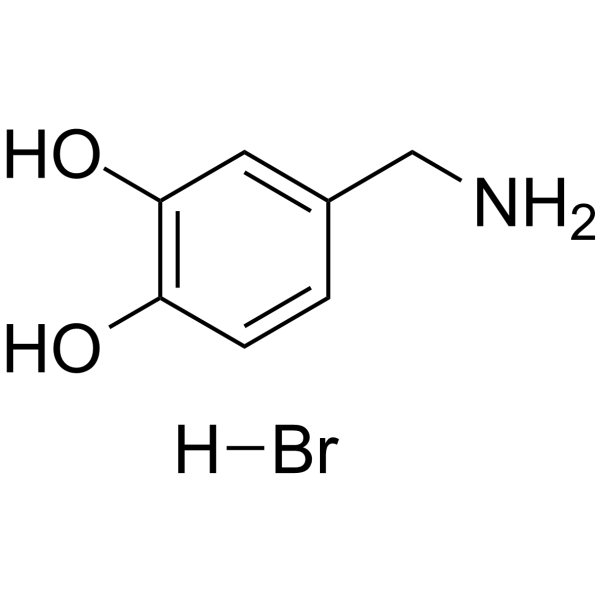
3,4-Dihydroxybenzylamine hydrobromide
CAS No. 16290-26-9
3,4-Dihydroxybenzylamine hydrobromide( NSC 263475 hydrobromide )
Catalog No. M26024 CAS No. 16290-26-9
3,4-Dihydroxybenzylamine hydrobromide inhibits DNA polymerase activity in melanoma cells and displays growth inhibitory activity in melanoma cell lines with varying degrees of tyrosinase activity.
Purity : >98% (HPLC)
 COA
COA
 Datasheet
Datasheet
 HNMR
HNMR
 HPLC
HPLC
 MSDS
MSDS
 Handing Instructions
Handing Instructions
| Size | Price / USD | Stock | Quantity |
| 100MG | 37 | In Stock |


|
| 200MG | Get Quote | In Stock |


|
| 500MG | Get Quote | In Stock |


|
| 1G | Get Quote | In Stock |


|
Biological Information
-
Product Name3,4-Dihydroxybenzylamine hydrobromide
-
NoteResearch use only, not for human use.
-
Brief Description3,4-Dihydroxybenzylamine hydrobromide inhibits DNA polymerase activity in melanoma cells and displays growth inhibitory activity in melanoma cell lines with varying degrees of tyrosinase activity.
-
Description3,4-Dihydroxybenzylamine hydrobromide inhibits DNA polymerase activity in melanoma cells and displays growth inhibitory activity in melanoma cell lines with varying degrees of tyrosinase activity.(In Vitro):3,4-Dihydroxybenzylamine hydrobromide (1 μM-10 mM; 48 hours) inhibits the growth of all melanoma cell lines (IC50 = 100 μM) and the SK-MELB cell line (IC50 = 122 μM). The IC50 values are 30, 84,90, and 68 μM for Human SK-MEL-30, SK-MEL-2, SK-MEL-3,RPMI-7951 cells, respectively. 3,4-Dihydroxybenzylamine hydrobromide (1 μM-10 mM; 48 hours) cytotoxicity in SK-MEL-2 and SK-MEL-28 cell lines can be enhanced by application of buthionine sulfoximine (BSO). BSO treatment sensitizes marginally pigmented cells to the effects of 3,4-DHBA, and the presence of decreses IC50 values of 3,4-DHBA by 127% in the SK-MEL-28 cell line and by 148% in the SK-MEL-2 cell line. 3,4-Dihydroxybenzylamine hydrobromide exhibits IC50values of 10, 25, 67, and 184 μM for S91A, S91B, L1210, and SCC-25 cells, respectively.(In Vivo):3,4-Dihydroxybenzylamine hydrobromide (200, 400, 600 and 800 mg/kg; i.p.; 21 days) has different effects at different doses, the median life-span are 17, 24.5, 26, 29 and 25 days respectively. 3,4-Dihydroxybenzylamine hydrobromide (1000 mg/kg; i.p.; 7 days) has the least toxic effect in non-tumor-bearing B6D2F1 mice,and mice is tolerated at this dose.
-
In Vitro3,4-Dihydroxybenzylamine hydrobromide (1 μM-10 mM; 48 hours) inhibits the growth of all melanoma cell lines with an IC50 of 100 μM, while the SK-MELB cell line exhibits an IC50 of 122 μM. The IC50 values are 30, 84,90, and 68 μM for Human SK-MEL-30, SK-MEL-2, SK-MEL-3,RPMI-7951 cells, respectively. It exhibits IC50values of 10, 25, 67, and 184 μM for S91A,S91B,L1210, and SCC-25 cells, respectively.3,4-Dihydroxybenzylamine hydrobromide (1 μM-10 mM; 48 hours) cytotoxicity in SK-MEL-2 and SK-MEL-28 cell lines can be enhanced by application of buthionine sulfoximine (BSO). BSO treatment sensitizes marginally pigmented cells to the effects of 3,4-DHBA, and the presence of decreses IC50 values of 3,4-DHBA by 127% in the SK-MEL-28 cell line and by 148% in the SK-MEL-2 cell line. Cell Viability Assay Cell Line:Human and Murine Melanoma Cell Lines; Non-Melanoma Cell Lines Concentration:1 μM-10 mM Incubation Time:48 hours Result:Inhibited melanoma cell Lines growth.
-
In Vivo3,4-Dihydroxybenzylamine hydrobromide (intraperitoneal injection; 1000 mg/kg; 7 days) has the least toxic effect in non-tumor-bearing B6D2F1 mice,and mice is tolerated at this dose.3,4-Dihydroxybenzylamine hydrobromide (intraperitoneal injection; 200-800 mg/kg; 21 days) has different effects at different doses, the median life-span are 17, 24.5, 26, 29 and 25 days for 0 mg/kg, 200 mg/kg, 400 mg/kg, 600 mg/kg, and 800 mg/kg, respectively. Animal Model:C57BL/6 mice withB6D2F1 cells Dosage:200 mg/kg, 400 mg/kg, 600 mg/kg, and 800 mg/kg Administration:Intraperitoneal injection Result:Exhibited increased life-span of 44%,46%, 70% and 50% for 200 mg/kg, 400 mg/kg, 600 mg/kg, and 800 mg/kg, respectively.
-
SynonymsNSC 263475 hydrobromide
-
PathwayOthers
-
TargetOther Targets
-
RecptorP450| protein tyrosine phosphatase(PTP)| SETD8
-
Research Area——
-
Indication——
Chemical Information
-
CAS Number16290-26-9
-
Formula Weight220.066
-
Molecular FormulaC7H10BrNO2
-
Purity>98% (HPLC)
-
SolubilityIn Vitro:?DMSO : 83.33 mg/mL (378.67 mM)
-
SMILESBr.NCc1ccc(O)c(O)c1
-
Chemical Name——
Shipping & Storage Information
-
Storage(-20℃)
-
ShippingWith Ice Pack
-
Stability≥ 2 years
Reference
1.Liljebris C, et al. Oxidation of protein tyrosine phosphatases as a pharmaceutical mechanism of action: a study using 4-hydroxy-3,3-dimethyl-2H-benzo[g]indole-2,5(3H)-dione. J Pharmacol Exp Ther. 2004 May;309(2):711-9.
molnova catalog



related products
-
Albaspidin AA
Albaspidin AA displays strong antibacterial activity against the vegetative form of P. larvae (MIC ranging from 0.168-220 uM).
-
Lupeolic acid
Lupeolic acid has anti-inflammatory activity.
-
Sodium gluconate
Sodium gluconate is a corrosion and scale inhibitor of ordinary steel in simulated cooling water.



 Cart
Cart
 sales@molnova.com
sales@molnova.com


